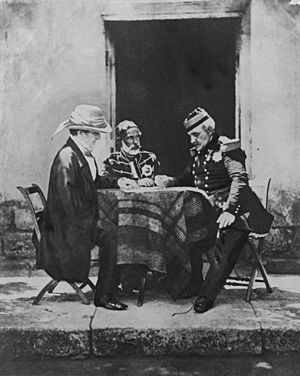Mamelon (fort) facts for kids
During the Crimean War (1853-1856), there was a very important battle called the Siege of Sevastopol (1854–1855). Sevastopol was a major Russian port city. A small hill, or hillock, near Sevastopol became a key battleground. The French soldiers called this hill the Mamelon (location: 44°36′02″N 33°33′22″E / 44.60048°N 33.55606°E). The British soldiers also used the name Mamelon, but sometimes they called it Gordon's Hill. This hill was very important because it offered a great view and control over the surrounding area.
Contents
The Mamelon Hill: A Key Battle Spot
The Mamelon was a strategic point during the long siege. Capturing it meant gaining a significant advantage over the enemy. Both sides knew how important this small hill was for controlling the battlefield around Sevastopol.
Early Attempts to Capture the Hill
In October 1854, the French army tried to capture the Mamelon hill quickly. This type of swift attack is called a coup de main. However, the Russian defenders fought back strongly. The French attack failed, and they lost about 600 soldiers. This showed how difficult it would be to take the Mamelon.
Russia's Strong Defenses
During the winter of 1854 and 1855, the Russians worked hard to make their defenses even stronger. They built a special fort, called a Redoubt, on top of the Mamelon. This fort was named the Kamtschatka Redoubt. It was part of a huge system of defenses around Sevastopol. These defenses included double and even triple lines of trenches and fortifications. The Mamelon, with its new redoubt, became a very tough place to attack.
The Final Attack and Capture
As the fighting continued into 1855, the Mamelon remained a target. After two more failed attempts to capture it, the Allied forces (French and British) planned a major assault. First, they heavily bombarded the Russian positions with cannons. Then, they captured some smaller defenses around the Mamelon. Finally, in early June, the French soldiers launched a massive attack on the Kamtschatka Redoubt itself. They managed to storm the fort and capture it.
During this final assault, the British soldiers helped by taking some nearby Russian positions. The British suffered about 30 officers and 350 other soldiers as casualties. The French, who led the main attack with many more troops, had even higher losses. Their casualties were about three times more than the British. Capturing the Mamelon was a big victory for the Allied forces, but it came at a high cost.


